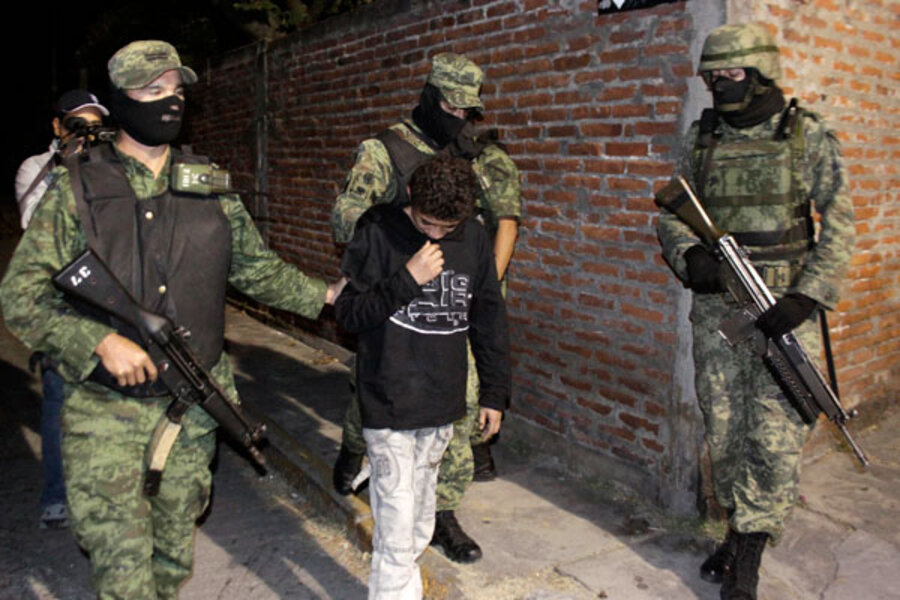Teen killer's light sentence dismays a violence-weary Mexico
Loading...
| Mexico City
When a teenager coldly confessed to his role in the assassination of four people, who were found beheaded and hanging from a bridge in Central Mexico last year, the nation was stunned. From new mothers to older Mexicans who have watched violence spiral in the past decade, they hoped that the shocking case would at least be a wakeup for a society that appears increasingly inured to murder.
This week, however, many of them are reacting bitterly to the sentence that was just handed down. Edgar Jimenez, better known as “El Ponchis” and dubbed by the media here as the “boy killer,” received three years in juvenile detention, a sixth of which he has already served. It is the maximum that the state of Morelos allows for minors.
“He might be a child, but he is a criminal,” says Maria Mojica, who says she is saddened by the violence that seems to overshadow everything else about this nation. “This will not instill fear in others who commit crimes.”
Young people are increasingly the perpetrators of violent crime in Mexico. Sometimes they are forcibly recruited and threatened by drug gangs. Other times the allure is too great, and drug money looks like an easy out in the face of few opportunities and impunity rates that are well over 90 percent. And while the sentence for Mr. Jimenez is considered too light by many, hardly dissuading others from killing for money, his case has underscored how much institutions have deteriorated in many parts of the country.
“Our system is not strong enough to enforce [the law],” says Elena Azaola Garrido, a criminal justice anthropologist at the Center of Research and Higher Education for Social Anthropology in Mexico City. “Children can take a chance because they see most are not captured. There are inadequate policies to tackle this.”
The killings and kidnappings that Jimenez was charged with riled Mexico last year, after the boy confessed on camera to his participation in the killings for a major criminal organization. He said he was threatened and drugged while committing crimes. "I slit their throats," Jimenez said.
Jimenez was born in San Diego, where his mother lives, but brought to Mexico by his father when he was a baby. He dropped out of school. He was arrested last December while attempting to board a flight to Tijuana with his sister.
The three-year sentence was not a surprise: it is the maximum allowed for Morelos, outside Mexico City, where the crimes were perpetrated. While organized crime cases are federal, there are no mechanisms in place to try minors at that level.
'It could have been a warning'
Still those Mexicans who sought to make the stunning case a lesson on consequences for other children were disappointed.
“This could have been a warning for others,” says Alicia Garcia, walking in the park with her son and dog on a brisk morning, who adds that even though the laws are different for minors and adults, “he committed the crimes of an adult.”
Teens and those even younger have long joined gangs in Central America, perpetrated horrific violence in Brazil, formed armies in Africa, and killed for cults, for revenge at school, and themselves.
But as violence worsens in Mexico, children here are increasingly vulnerable to the drug groups that are behind tens of thousands of murders in recent years throughout the country.
One of the most vulnerable is the group dubbed ni-nis, youths who neither work nor are in school. In a July 24 editorial in its magazine, the archdiocese of Mexico recently said that there are potentially millions of such children who could be recruited by criminals with easy money. At a recent US Agency for International Development (USAID), US Department of State and Organization of American States (OAS) conference on youth development and crime prevention, OAS head José Miguel Insulza said that one of three young people in the region neither works nor studies.
“(They) are the most vulnerable to the lure of crime,” he said.
The conference noted that governments need to work harder to change the image of youths from generators of violence to positive agents of change and need to create programs that allow them to realize their potential.
Ms. Azaola says that many young children like Jimenez are demonized, but that a whole host of institutions are to blame.
“The media is just talking about a three-year sentence not being enough. They don’t also talk about the conditions in which this little boy grew up,” she says. “We have to look at the responsibility of families and institutions that failed to protect and give him any rights.”





